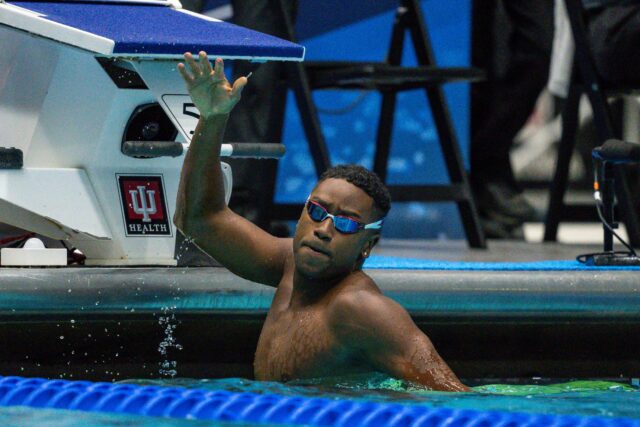By James Sutherland on SwimSwam

Every swimmer knows the importance the flags have while swimming backstroke. They let you know when the wall is coming, helping avoid a mistimed turn, or if you’re coming in for a finish, a direct hit with the wall.
During a practice in the fall of 2021, the absence of the flags resulted in a life-altering incident for Alexandra Chrisman.
Chrisman competed at the AAU Junior Olympic Games representing the Arkansas Zone Team in the summer of 2021, and was practicing with her home club, the Central Arkansas Racers, early the next season.
Due to a pool closure for renovations at the team’s usual facility in Bryant, Ark., her group was practicing in Benton with the squad that usually swims there—the Racers have groups training out of multiple sites—which made the lanes extra crowded.
During one of the first practices in Benton, Chrisman, 13 at the time, had a head-on collision with another swimmer that resulted in broken goggles.
A few days later, the swimmers were doing double-arm backstroke without the flags in place.
“They had taken the flags down while they were performing the double arm backstroke drill,” said Zane Chrisman, Alexandra’s mother.
“I was sitting up in the stands watching them while they were doing it. And, as a parent, you’re sitting there and thinking this is kind of concerning. But at the same time, they’ve got all these coaches that know what they’re doing and it’s going to be fine.”
Zane figured Alexandra had swum at the pool enough times to recognize when the wall was near based on the crossings on the ceiling.
But Alexandra didn’t take into account the extra force exerted by using both arms. She mistimed the wall and hit her head.
“When she hit the wall, you could hear the loud ‘crack’ reverberating off of the natatorium. It was so loud,” Zane said.
Alexandra was immediately pulled out of the water and checked out. Her head hurt, but nothing out of the ordinary given what had just happened, so she completed the practice.
At the following night’s practice, she expressed that she hadn’t been feeling well all day, her head was hurting more and she felt lightheaded and nauseous.
Typical symptoms of a concussion, Zane noted, but because the response wasn’t immediate, they didn’t quite put the pieces together.
Another headache the following day led them to the doctor for the first time, where some medicine was prescribed to deal with what was perceived to just be a migraine.
After symptoms continued, they visited the hospital. Alexandra was left alone waiting for “nine or 10 hours” and began having panic attacks after being left in a “hospital closet” for such a long period of time while the pain continued to mount.
The doctors still brushed it off as a migraine. However, about two weeks later, Zane came home to find her son urging her that “something’s wrong” with Alexandra. She had lost her vision and hearing while taking a shower, and was feeling lightheaded.
They went back to the hospital; things were brushed off as being temporary again. After seeing several different specialists, Alexandra was ultimately diagnosed with postural orthostatic tachycardia syndrome (POTS), which is one of a group of disorders whose primary symptom is orthostatic intolerance—a feeling of lightheadedness when you stand up. Symptoms can impact every part of the body, but headaches, chest pain, and nausea like Alexandra experienced are common. Concussions are known to be the second most common trigger for people to develop POTS.
Alexandra tried to keep swimming a bit, as the water can act as a form of compression around the body to alleviate symptoms, but that often resulted in her having to be carried out of the water mid-practice. Her symptoms continued to worsen to the point that she could barely take a bite of food without being in “extreme pain.” She ended up losing over 50 pounds in two months.
Alexandra said prior to the incident, she had it in her mind that she was going to have a big season and try and qualify for the state championships. Two months later she couldn’t get through a practice. Eventually, the family moved from Arkansas to Texas to be close to specialists.
“I was so depressed and I was hurting so badly,” said Alexandra, who said she began questioning her faith. “Why would this ever happen to me and why did it have to happen at this time. I was just wondering why God could do something like that to someone. Why would he do this to anyone really?”
Alexandra is now being homeschooled and uses a feeding tube 20 hours a day. She can make her way around the house on her own sometimes, but when feeling weak she needs a walker to get from her room to the kitchen. She usually uses a wheelchair when they go out.
“I’m telling you this is hell,” said Zane. “This is hell.”
Alexandra had always wanted to swim in college but is now hoping there’s a chance she can still be a part of a team in a different capacity, possibly as a student assistant coach or team manager. She also wants to make sure swimmers know the signs of concussions and are made aware of the dangers of the double-arm backstroke drill—especially if the flags are down.
Her advocacy has already made a small difference. Her former coach now requires all swimmers to either stop or change to a freestyle finish as soon as they see the flags when they are doing double-arm backstroke. She is hoping that these rules are applied to all swimmers now that she is dealing with the repercussions of this accident.
Zane remains optimistic that progress will be made in treatment for POTS as more cases have popped up in the aftermath of the COVID-19 pandemic, specifically with Long COVID, leading to more research on the condition.
“We don’t give up,” she said.
SwimSwam: “This Is Hell”: How A Mistimed Backstroke Wall Changed A Young Swimmer’s Life

















You must be logged in to post a comment Login